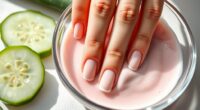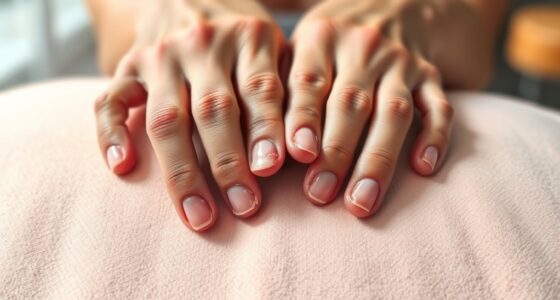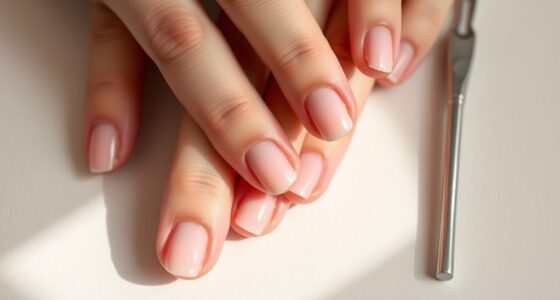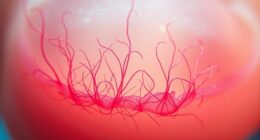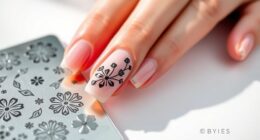To recover your natural nails after acrylics or gels, start by honestly evaluating their health and giving them a break from enhancements. Follow a gentle routine: moisturize regularly, trim cuticles carefully, and avoid harsh chemicals. Focus on a balanced diet rich in biotin, vitamins, and hydration. Use nourishing products and avoid water exposure and trauma. Consistent care speeds up recovery, and if persistent issues arise, seeking professional advice helps ensure proper healing. Keep going, and you’ll discover tips to restore your nails effectively.
Key Takeaways
- Give your nails a break from enhancements to allow natural recovery and growth.
- Follow a consistent, nourishing routine with cuticle oils and moisturizers to strengthen nails.
- Assess nail health regularly, monitor progress, and seek professional advice if issues persist.
- Maintain a balanced diet rich in biotin, vitamins, and minerals to support nail regeneration.
- Avoid harsh chemicals, water exposure, and trauma to prevent further damage and promote healthy growth.
Assessing the Damage and Setting Realistic Goals

Before you begin the recovery process, it is essential to assess the current state of your nails honestly. Take a close look at your nail health and identify any signs of damage, such as brittleness, peeling, or discoloration. This damage assessment helps you understand how much recovery your nails need and prevents unrealistic expectations. Be objective—note if your nails are thin, ridged, or lacking strength. Setting realistic goals based on this assessment allows you to focus on gradual improvements rather than expecting instant perfection. Remember, healthy nails take time to recover, especially after acrylic or gel enhancements. By honestly evaluating your nails now, you create a clear starting point for your recovery journey and develop a tailored plan to restore their natural strength and appearance.
Giving Your Nails a Break From Enhancements
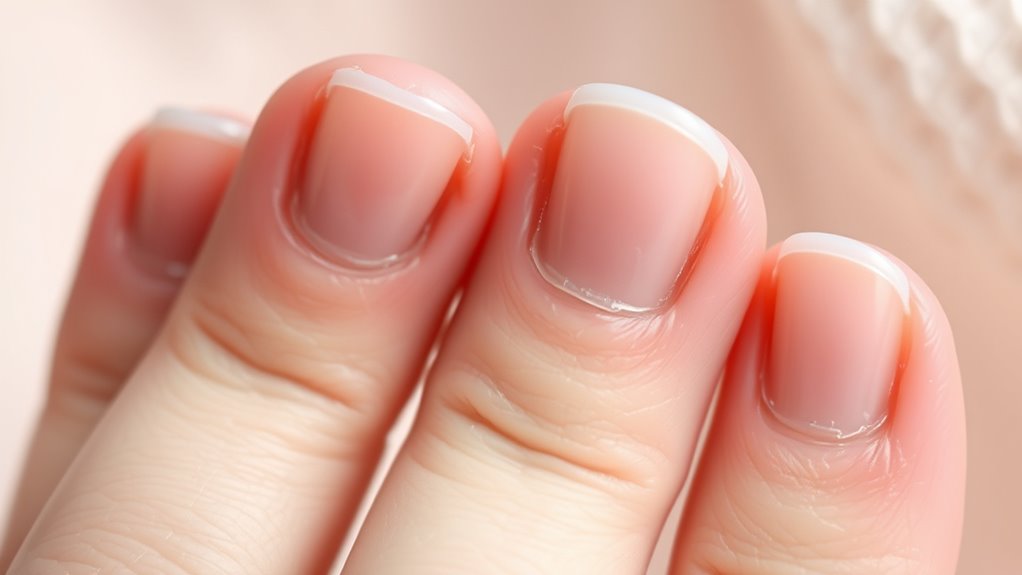
Taking a break from nail enhancements allows your natural nails to recover and grow stronger. Understanding the typical nail recovery timeline helps you stay patient and motivated during this process. To encourage healthy growth, follow simple tips like moisturizing regularly and avoiding harsh chemicals. Incorporating proper lifestyle habits can further support your nails’ health and resilience.
Nail Recovery Timeline
Giving your nails a break from enhancements is essential for their recovery, but understanding the typical timeline helps set realistic expectations. Usually, your nails need about 4 to 6 weeks to regain strength and health. During this period, avoid nail polish and nail art that can stress or damage your nails further. Patience is key to seeing visible improvements. Additionally, incorporating proper nail care techniques can significantly aid in the healing process. To help speed up recovery, keep nails moisturized and avoid harsh chemicals. Remember:
- Your nails will gradually grow out, revealing healthier tissue underneath.
- The initial weeks may show peeling or brittleness, which is normal.
- Consistent care and gentle handling are crucial for ideal recovery.
Knowing this timeline helps you stay motivated and focused on nurturing your natural nails.
Tips for Natural Growth
Allowing your nails to breathe by taking a break from enhancements is essential for natural growth. During this time, focus on proper nail care, starting with gentle nail polish removal to avoid damaging your weakened nails. Avoid harsh acetone-based removers and opt for nourishing removers instead. Regular cuticle trimming helps keep your nails healthy and prevents hangnails, but do so carefully to avoid injury. Keep your nails moisturized with cuticle oil and hand creams to promote hydration and strength. Limit exposure to water and harsh chemicals, which can weaken nails further. Giving your nails a break allows them to recover and grow stronger over time. Consistent, gentle care is key to restoring your natural nails after acrylics or gels. Incorporating proper exfoliation can also help remove dead skin cells and promote healthier nail beds.
Establishing a Nourishing Nail Care Routine

Establishing a nourishing nail care routine is essential for restoring and maintaining healthy natural nails. Consistency helps repair damage and promotes growth. To support this, incorporate daily practices like applying cuticle oils to hydrate and strengthen your nails. Regular nail massages stimulate blood flow, encouraging healthy growth and reducing brittleness. Here are three key steps:
Consistent nail care with oils and massages promotes healthy, strong nails.
- Use cuticle oils daily to lock in moisture.
- Incorporate gentle nail massages to boost circulation.
- Keep nails clean and dry to prevent infections.
Additionally, choosing appropriate nail care products can further enhance nail health and aid in recovery.
Choosing the Right Products for Strengthening

Choosing the right products is essential for effectively strengthening your natural nails. Start by selecting nail polish formulations that are free from harsh chemicals like formaldehyde or toluene, which can weaken your nails further. Look for formulas enriched with strengthening ingredients such as biotin or keratin to promote healthier growth. Don’t overlook the importance of cuticle oil benefits; applying a nourishing oil daily helps improve hydration, reduce peeling, and support new nail growth. Choose cuticle oils with ingredients like vitamin E, jojoba, or almond oil for ideal results. Using these products consistently will help repair damage, increase flexibility, and provide a solid foundation for stronger, healthier nails. Remember, the right combination of products makes a noticeable difference in your recovery process. Proper nail care routines are vital for maintaining long-term nail health and preventing future damage.
Incorporating Dietary and Lifestyle Changes
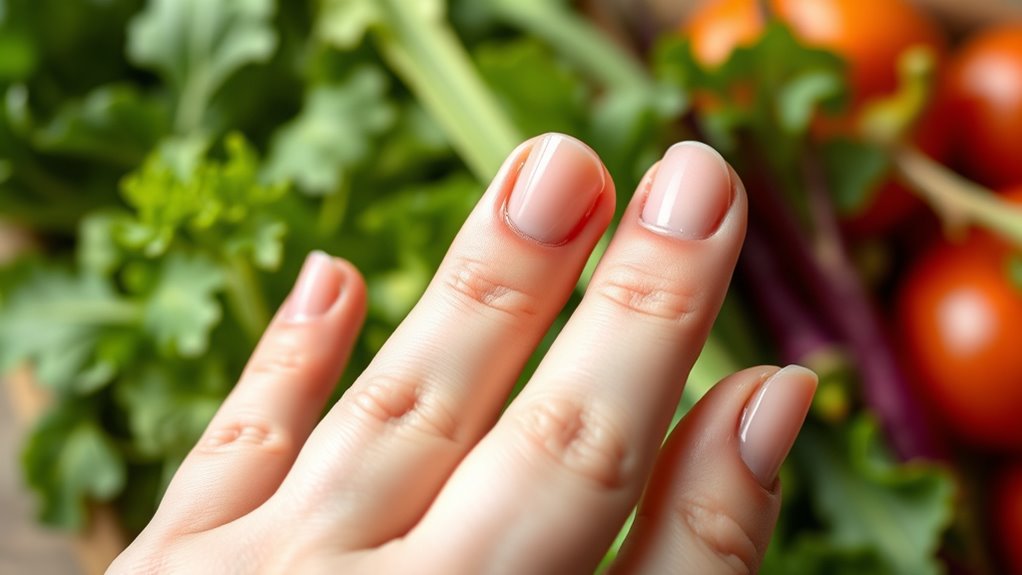
To support the healing process from the inside out, paying attention to your diet and lifestyle makes a significant difference. Improving your nutrient intake and hydration habits can boost nail recovery and strength. Focus on eating foods rich in biotin, zinc, and vitamins A, C, and E, which promote healthy nail growth. Staying well-hydrated helps prevent brittle nails and keeps them flexible. Here are some tips to incorporate into your routine:
- Consume a balanced diet with plenty of fruits, vegetables, lean proteins, and whole grains.
- Drink at least 8 glasses of water daily to maintain hydration.
- Limit processed foods and excessive sugar, which can negatively affect nail health.
Gentle Techniques for Nail and Cuticle Care
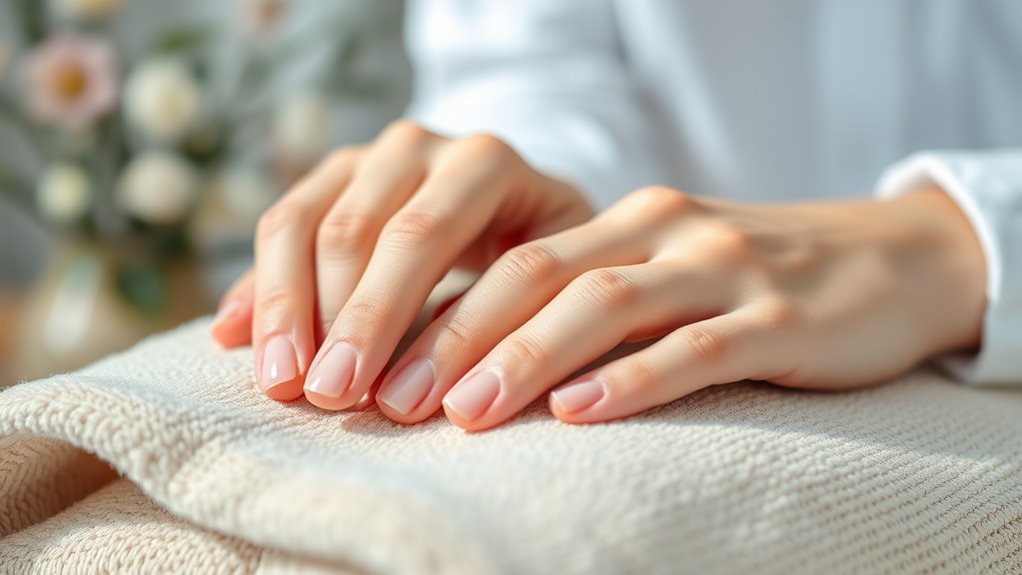
Taking a gentle approach to nail and cuticle care is essential for preventing damage and encouraging healthy growth. Start with a mineral soak to soften your nails and cuticles, reducing the need for harsh scraping. After soaking, gently massage your cuticles with light pressure to improve circulation and promote healing. This cuticle massage helps nourish the area and prevents hangnails or tears. Avoid aggressive pushing or cutting, which can harm your nails. Instead, use a soft implement or your fingertips to gently push back the cuticles once softened. Keep your nails moisturized with nourishing oils or creams, and always handle your nails delicately. Incorporating advanced natural recovery techniques supported by recent breakthroughs in machine learning can optimize your nail health routine. These gentle techniques support natural recovery and build a strong foundation for healthy, beautiful nails.
Monitoring Progress and Knowing When to Seek Professional Help
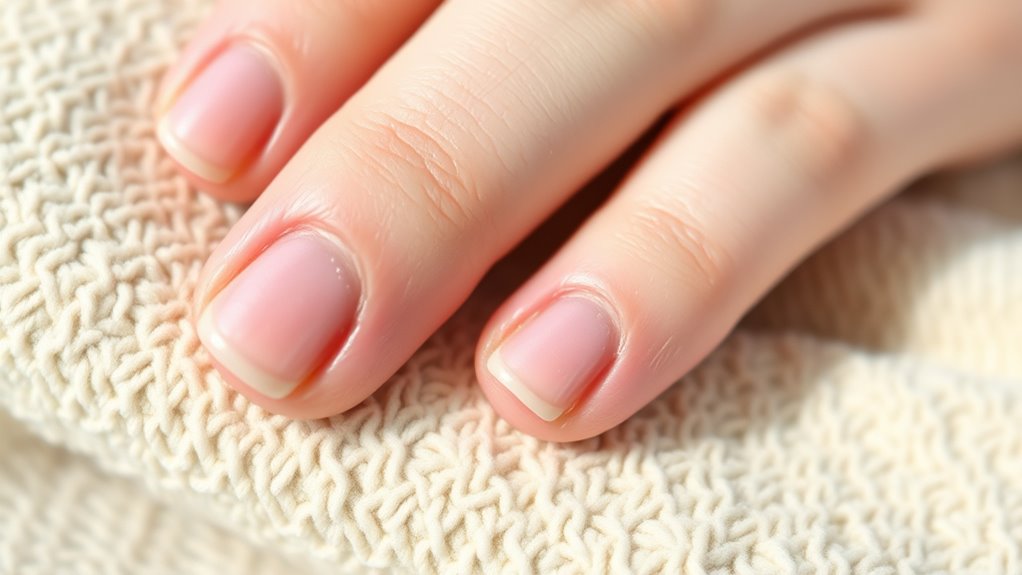
Monitoring your progress is crucial to guarantee your nails are healing properly. Keep a close eye on signs of infection, such as redness, swelling, or pus, and watch for nail discoloration, which can indicate underlying issues. If you notice persistent pain or your nails remain discolored after several weeks, it’s time to seek professional help.
A father’s guidance can often provide valuable support during recovery, emphasizing the importance of care and patience.
Here are key signs that warrant a consultation:
- Unusual nail discoloration that doesn’t improve
- Signs of infection like warmth, swelling, or discharge
- Persistent pain or discomfort around the nails
Prompt professional advice ensures proper treatment and helps prevent further damage, so don’t ignore persistent symptoms. Regular monitoring keeps your nail recovery on track.
Frequently Asked Questions
How Long Does It Typically Take for Natural Nails to Fully Recover?
It typically takes about 4 to 6 weeks for your natural nails to fully recover, depending on their initial health and the extent of damage. During this recovery timeline, focus on maintaining good nail health by moisturizing, avoiding harsh chemicals, and giving your nails a break from polish or extensions. Patience is key, and with proper care, you’ll notice stronger, healthier nails emerge over time.
Can I Use Home Remedies to Speed up Nail Recovery?
Yes, you can try home remedies to speed up nail recovery. Applying nourishing oils like coconut or castor oil can boost moisture and promote growth. Biotin supplements may strengthen your nails over time. Keep your nails hydrated, avoid harsh chemicals, and give them time to breathe. While home remedies help, patience is key; consistent care accelerates your nail recovery naturally and safely.
Are There Specific Vitamins That Promote Healthy Nail Growth?
Yes, certain vitamins promote healthy nail growth. You should consider taking vitamin supplements like biotin, vitamin E, and zinc, which strengthen nails and support regeneration. Incorporate nail health foods into your diet, such as eggs, nuts, leafy greens, and fish, to provide essential nutrients. Staying consistent with these supplements and foods can help restore your nails’ natural strength and improve their overall appearance after acrylics or gels.
How Do I Prevent Future Damage From Acrylics or Gels?
To prevent future damage from acrylics or gels, you should focus on nail strengthening and proper maintenance. Always give your nails a break between salon visits, use nourishing cuticle oils, and avoid harsh chemicals. Protect your nails with a base coat and opt for professional application. Staying hydrated and maintaining a healthy diet also support damage prevention, keeping your natural nails strong and resilient for the future.
When Should I See a Dermatologist for Nail Concerns?
Don’t wait if you notice nail infections or allergic reactions, because delaying can worsen your condition. You should see a dermatologist promptly when you experience persistent pain, swelling, redness, or unusual discoloration, especially after acrylics or gels. These signs could indicate an infection or allergic response, and early treatment helps prevent further damage. Trust your instincts—your dermatologist can diagnose issues and recommend the best course of action for healthy nails.
Conclusion
Remember, patience is a virtue when healing your natural nails. With consistent care, nourishing routines, and gentle techniques, you’ll see progress over time. Don’t rush the process—your nails need time to recover and regain strength. Keep in mind the old saying, “Good things come to those who wait.” Stay committed, and soon you’ll be flaunting healthy, beautiful nails that reflect your true natural beauty.

